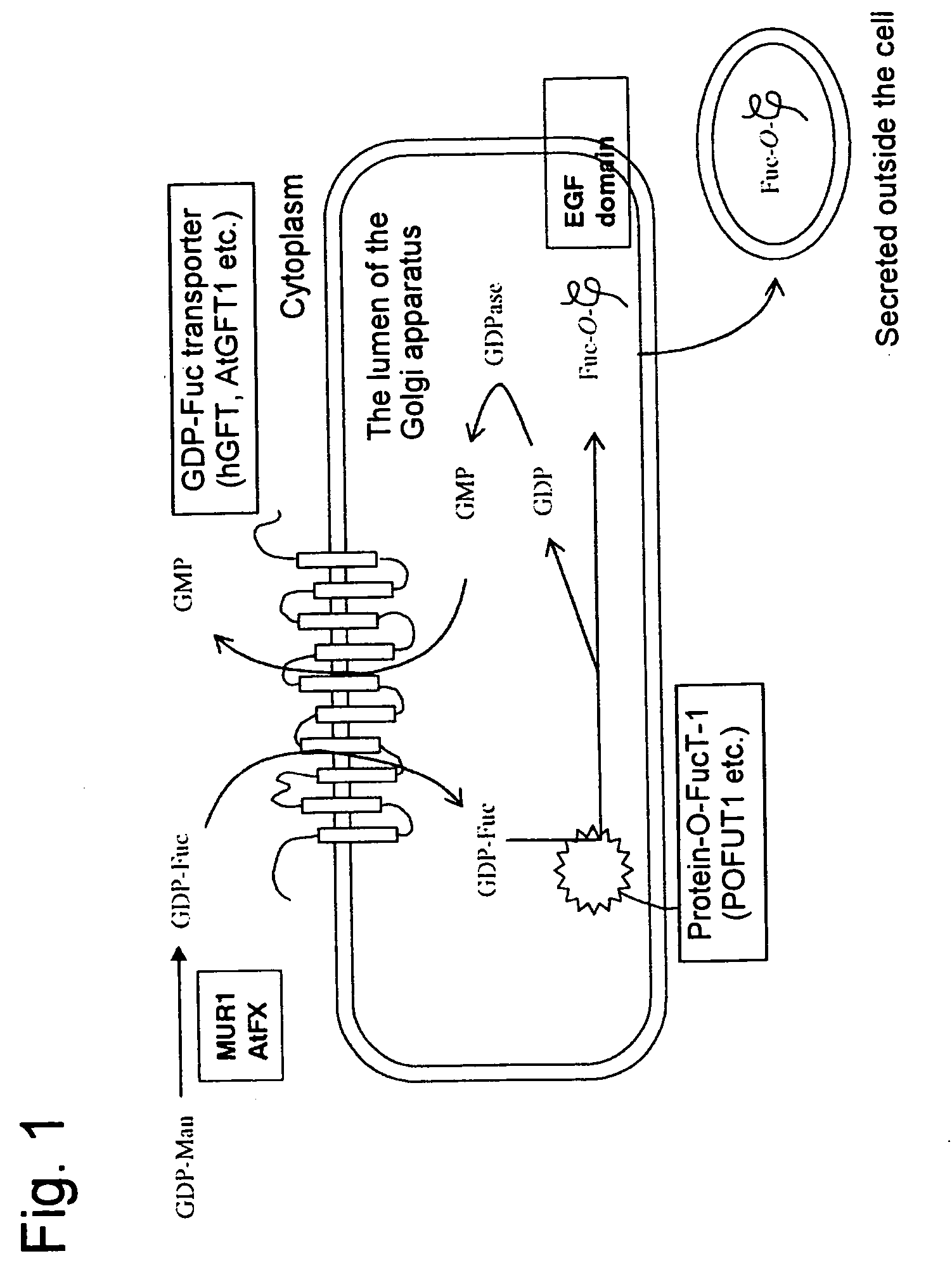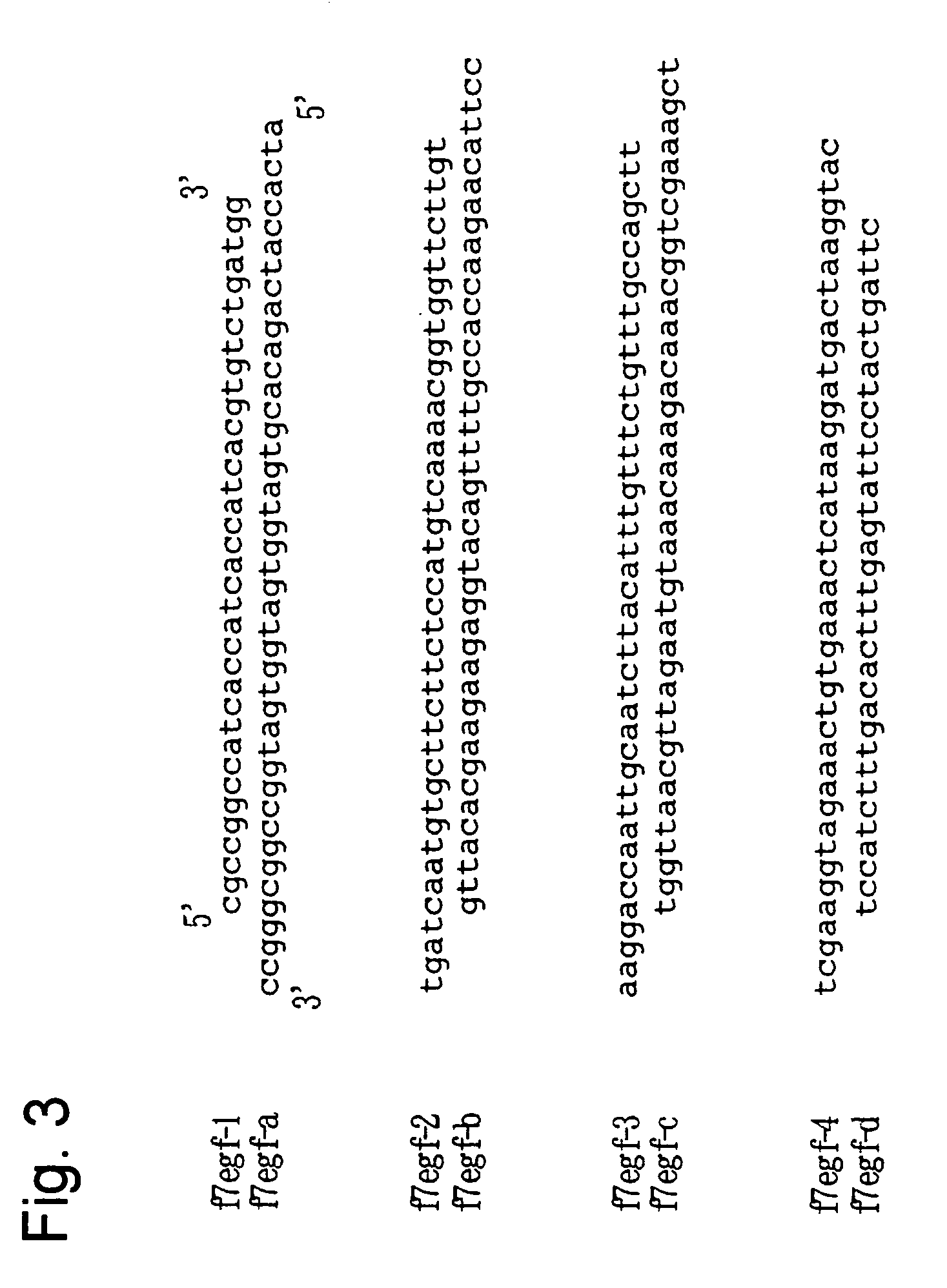Yeast transformant into which genes associated with synthesis system of O-fucosylated protein are introduced
a technology of o-fucosylated protein and transformant, which is applied in the field of yeast transformant, can solve the problems of inability to achieve the metabolic pathway of protein modification with sugar chains in prokaryotes, inability to produce o-fucosylated protein, and inability to synthesis system of o-fucosylated protein, etc., and achieve the effect of efficient production of o-fucosylated protein
- Summary
- Abstract
- Description
- Claims
- Application Information
AI Technical Summary
Benefits of technology
Problems solved by technology
Method used
Image
Examples
example 1
Preparation of Strain Wherein Each Gene Associated with the Synthesis System of O-Fucosylated Protein is Introduced
(1) Preparation of YCH01 Strain
[0066] An hGFT gene is located on human chromosome 20, and the cDNA nucleotide sequence of the hGFT gene has been registered under AF326199 in a database. The full-length cDNA of the hGFT gene was amplified by PCR using primer A (AATGAGCTCATGAATAGGGCCCCTCTGAAG: SEQ ID NO: 13) and primer B (ACTCTAGATCATTTACCCAATCTATTCATTTCAATATCAGTGTACACCCCCAT GGCGCTCTTC: SEQ ID NO: 14). A human brain-derived cDNA library (Clontech) was used as a template. Primer B was designed to encode a VSVG antigen (to be used for confirming expression), so that the thus amplified DNA fragment will be expressed as protein having the tag fused to the 3′ side. The PCR product was cleaved at the Sac I and Xba I site and then incorporated into the Sac I / Xba I site of a previously reported plasmid Yep352GAPII, thereby constructing a plasmid YEp352GAP-hGFT / VSVG whereby the...
example 2
Preparation of Strains Wherein all the Genes Associated with the Synthesis System of O-Fucosylated Protein are Introduced
(1) Preparation of S. cerevisiae YCH09 Strain and YCH10 Strain
[0076] The transformed strains (the S. cerevisiae YCH01 strain was crossed with YCH03 strain, and the S. cerevisiae YCH02 strain was crossed with YCH03 strain) were each crossed on an YPAD medium plate. The thus crossed strains were each inoculated on an SD-Ura / Leu medium plate (2% glucose, 0.67% Yeast Nitrogen Base w / o amino acids (produced by Difco Laboratories), nucleic acid bases excluding uracil and leucine, and an amino acid mixture (20 to 400 mg / l)) and then cultured at 30° C. for 2 days, thereby selecting diploids. The thus obtained diploids were separated by tetrad analysis and then replicated on SD-Ura / Leu medium plates, thereby obtaining target transformants (the S. cerevisiae YCH06 strain and the S. cerevisiae YCH07 strain).
[0077] The transformed strains (the S. cerevisiae YCH04 strain a...
example 3
Confirmation of Gene Expression
(1) Confirmation of Gene Expression in the S. cerevisiae YCH09 Strain and YCH10 Strain
[0081] The S. cerevisiae YCH09 strain and the S. cerevisiae YCH10 strain prepared in Example 2 were cultured in 3 ml of an YPAD medium (2% polypeptone, 1% yeast extract, 2% glucose, and adenine (40 mg / l)) at 30° C. for 12 hours. Microbial bodies were collected by centrifugation. The microbial bodies were disrupted using glass beads. After solubilizing insoluble protein by adding a surfactant to a disruption solution, a supernatant was obtained by centrifugation. The obtained supernatant, which was a crude enzyme solution, was denatured using an SDS sample buffer, and then subjected to Western blot analysis according to a conventional method. In Western blot analysis, a goat anti-VSVG antibody, a mouse anti-HA antibody, a mouse anti-myc antibody, and a mouse anti-FLAG antibody were used as primary antibodies. When the goat anti-VSVG antibody was used as a primary an...
PUM
| Property | Measurement | Unit |
|---|---|---|
| pH | aaaaa | aaaaa |
| flow rate | aaaaa | aaaaa |
| detection wavelength | aaaaa | aaaaa |
Abstract
Description
Claims
Application Information
 Login to View More
Login to View More - R&D
- Intellectual Property
- Life Sciences
- Materials
- Tech Scout
- Unparalleled Data Quality
- Higher Quality Content
- 60% Fewer Hallucinations
Browse by: Latest US Patents, China's latest patents, Technical Efficacy Thesaurus, Application Domain, Technology Topic, Popular Technical Reports.
© 2025 PatSnap. All rights reserved.Legal|Privacy policy|Modern Slavery Act Transparency Statement|Sitemap|About US| Contact US: help@patsnap.com



